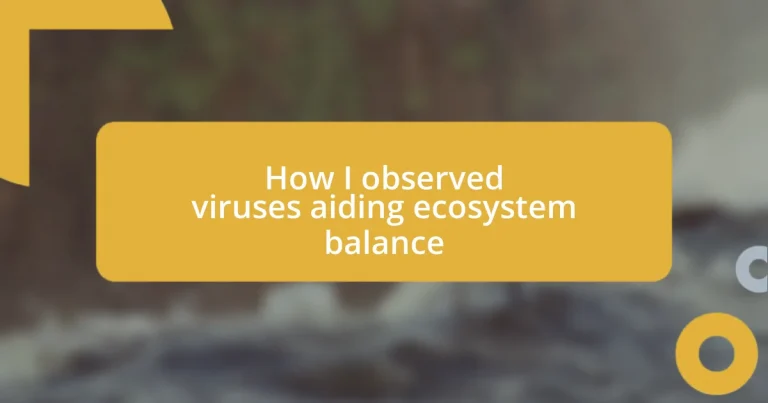Key takeaways:
- Viruses play essential roles in regulating populations and maintaining ecological balance by controlling the growth of bacteria, fungi, plants, and animals.
- They are integral to nutrient cycling, aiding in the decomposition of organic matter and supporting plant health through nutrient release.
- Understanding viral dynamics can lead to practical applications in agriculture, including sustainable farming practices and innovative pest management strategies.
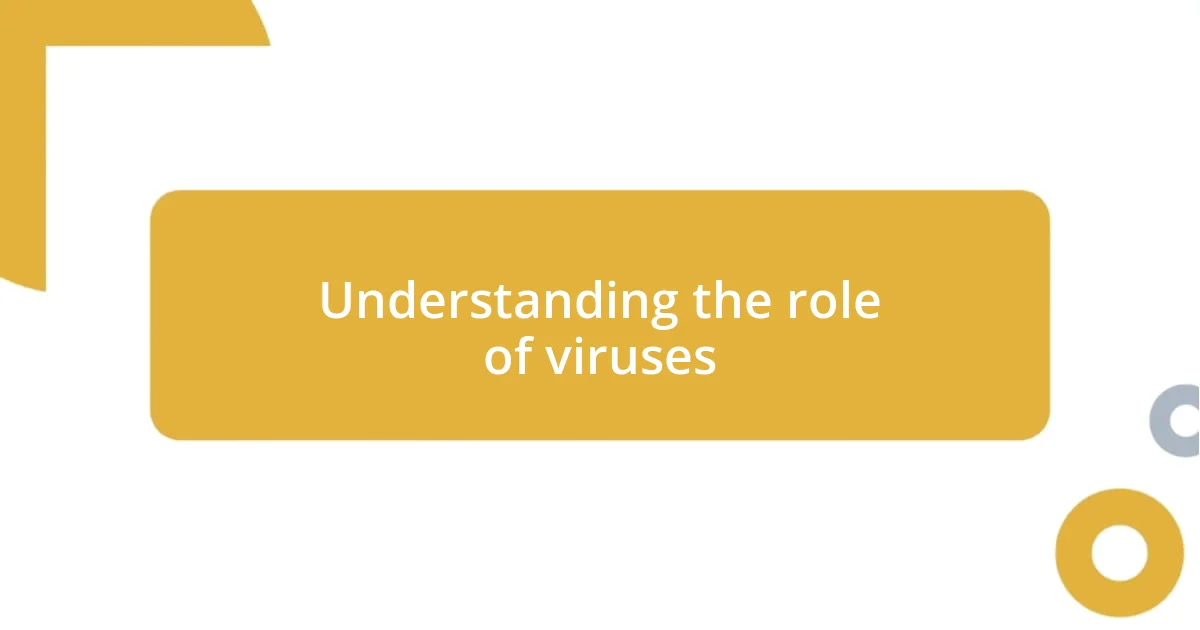
Understanding the role of viruses
Viruses often get a bad rap, and I can understand why—they’re usually associated with illness. But through my own experiences in the field, I’ve come to appreciate their more subtle roles in nature. Have you ever considered how these tiny entities can dictate the health of entire ecosystems?
While studying coastal ecosystems, I observed how marine viruses can regulate bacterial populations. This balance is crucial because it prevents any single type of bacteria from overwhelming others. Watching this interplay was like viewing a well-rehearsed dance, each partner knowing their steps to maintain harmony. Isn’t it fascinating how a virus can be a catalyst for ecological balance, orchestrating life in ways we often overlook?
In the soil, I’ve seen how viruses infect bacteria, which, in turn, releases nutrients that plants can absorb. This process reminded me of a hidden engine driving the vibrant greenery around us. It raises an intriguing question: if viruses are so integral to nutrient cycling, how might our perspective shift if we viewed them as nature’s unsung heroes rather than mere pathogens?
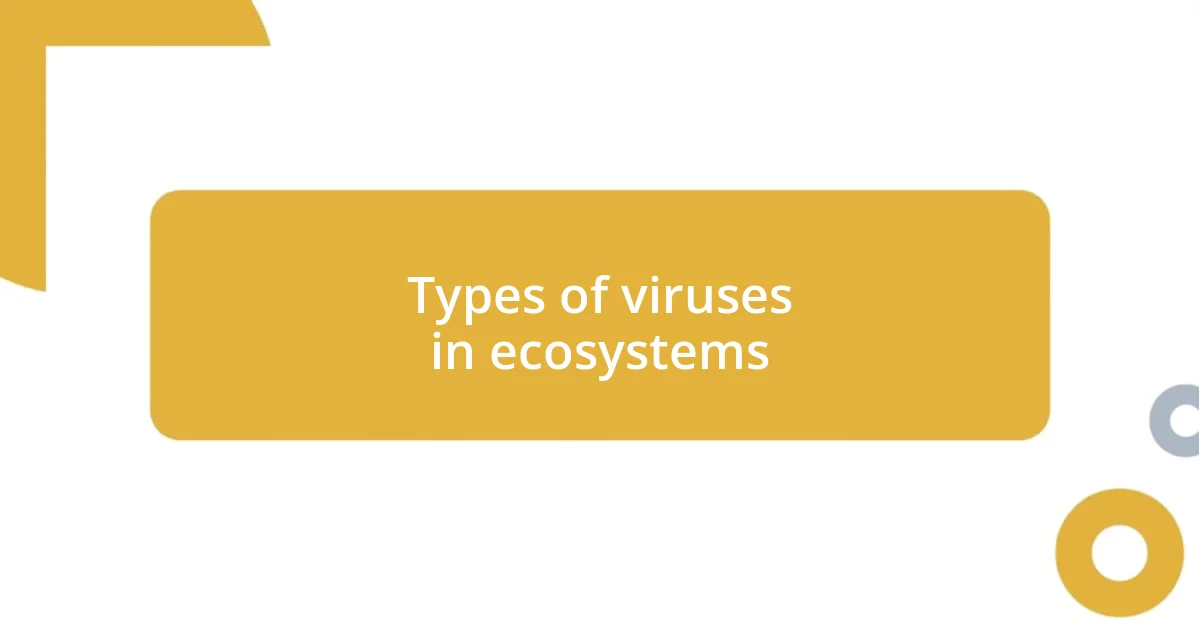
Types of viruses in ecosystems
When delving into the diverse types of viruses in ecosystems, I discovered that they can be broadly categorized based on their hosts. Some viruses specifically target bacteria, known as bacteriophages, while others may infect higher organisms like plants or animals. It’s intriguing to think about how these tiny biological agents are specialized and precise in their actions, much like a skilled artisan with their chosen tools. During my fieldwork, I once encountered a vibrant patch of seaweed thriving in a tidal pool, only to learn that specific viruses were regulating its bacterial companions, ensuring a healthy balance.
- Bacteriophages: These are viruses that infect bacteria and play a significant role in controlling bacterial populations. They can be pivotal in nutrient cycling and maintaining microbial diversity.
- Plant viruses: These viruses infect plants, often influencing their growth and development. Interestingly, some plants might use this infection to promote resistance against other diseases.
- Animal viruses: While often seen as harmful, some animal-infecting viruses can be crucial for population control within ecosystems, preventing overpopulation and fostering diversity.
- Mycophages: These viruses specifically infect fungi. Their role in controlling fungal populations can also indirectly affect plant health, as fungi interact heavily with plant roots.
Reflecting on these types reinforces a sense of awe in me. The interconnectedness of life forms and their reliance on these tiny agents challenges our traditional views on what constitutes a ‘virus.’ In my observations, it often felt like each virus had a unique part to play in the grand symphony of the ecosystem, revealing a complexity that’s both beautiful and vital for balance.
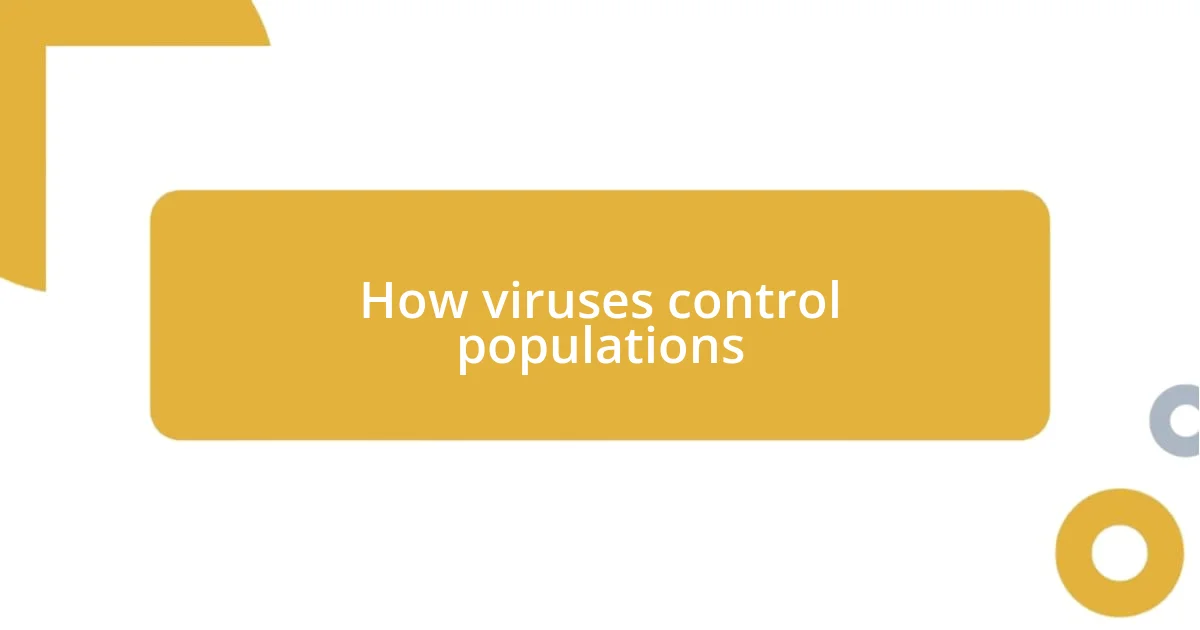
How viruses control populations
Viruses exert a surprising control over populations by acting as natural regulators. During one particular field study, I was captivated by how a single type of bacteriophage could dramatically reduce a booming bacterial population in a freshwater pond. It was like watching a delicate scale tip back to equilibrium, showcasing the power of viruses to restore balance. Who would have thought that such minuscule agents could have such profound effects on community structure?
In my experience observing viral dynamics, it’s clear that they can prevent the dominance of certain species. For instance, in a dense algal bloom, specific viruses could decimate the most prolific types of algae, allowing others to flourish. This interaction reminded me of a coach strategically subbing players to keep the game competitive. It’s intriguing to consider that these viral activities not only manage species populations, but they also maintain biodiversity, which is essential for ecosystem resilience.
A noteworthy observation happened while studying a coral reef. I noticed that specific viruses targeting certain bacteria were crucial in maintaining the health of corals. Without these viruses, harmful bacteria could proliferate unchecked, leading to coral bleaching events. It struck me that these hidden players, often dismissed as mere nuisances, are, in fact, vital protectors of complex ecosystems, acting tirelessly to ensure survival and diversity. How could we ignore the intricacies of these relationships that showcase the elegance of nature at work?
| Viruses | Population Control Mechanisms |
|---|---|
| Bacteriophages | Regulate bacterial populations, preventing overgrowth |
| Plant Viruses | Influence plant growth and resistance, occasionally aiding healthy plant diversity |
| Animal Viruses | Control animal populations, contributing to ecosystem balance |
| Mycophages | Regulate fungal populations, indirectly supporting plant health |
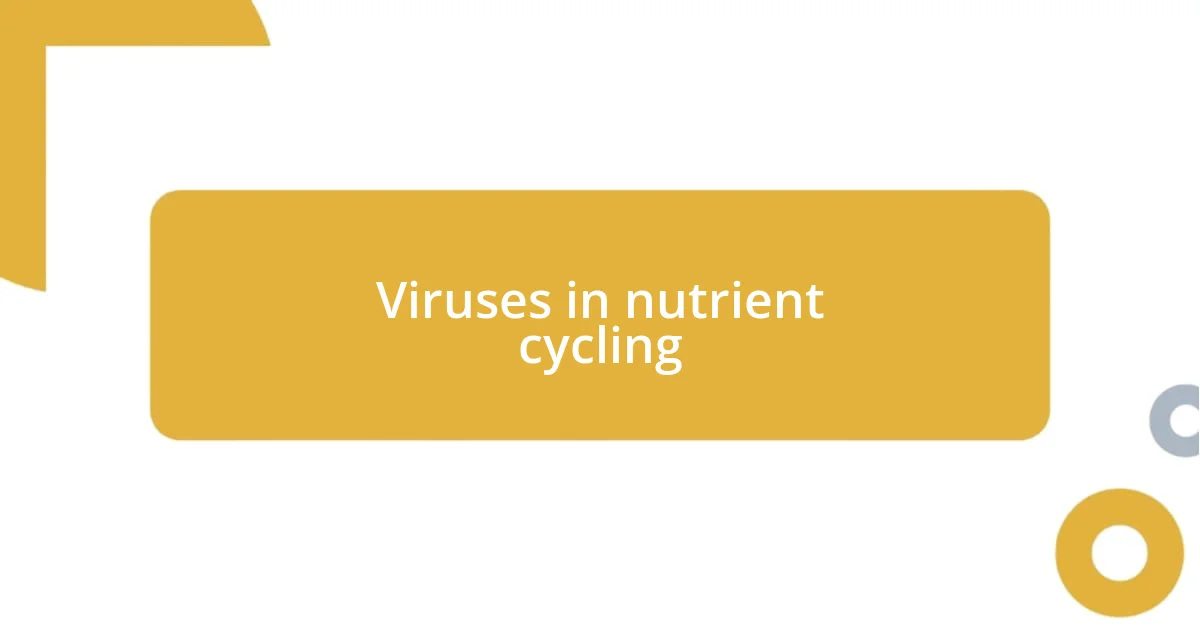
Viruses in nutrient cycling
Viruses play a surprisingly pivotal role in nutrient cycling, something I often reflect on during my explorations. Just imagine a world where bacteriophages not only attack bacteria but also break down organic matter and recycle nutrients back into the ecosystem. When I was studying a muddy marsh, I witnessed how these viruses helped decompose dead microbes, releasing vital nutrients like nitrogen and phosphorus. It felt like I was watching a hidden mechanism, gracefully working to keep the community alive and thriving.
During a memorable dive in a coastal environment, I encountered a bloom of phytoplankton. It fascinated me to learn that viruses attacking these algae are essential for cycling nutrients. Whenever certain species became too dominant, these viruses would swoop in and keep populations in check, ensuring a diverse array of phytoplankton could flourish. It made me consider: without these viral interventions, could we have unchecked growth that ultimately chokes off entire ecosystems?
I also remember my time observing soil ecosystems where mycophages were hard at work. They target fungal populations, aiding in the release of nutrients locked within organic material. It was awe-inspiring to realize that by controlling fungi, these viruses allow plants to access critical resources for growth. This connection led me to wonder: how many other unseen relationships in nature rely on these small yet mighty viruses to sustain balance and health? Each observation left me with a deeper appreciation for the intricate interplay of life, and a sense that viruses are far more than mere pathogens—they’re vital partners in the complex dance of nutrient cycling.
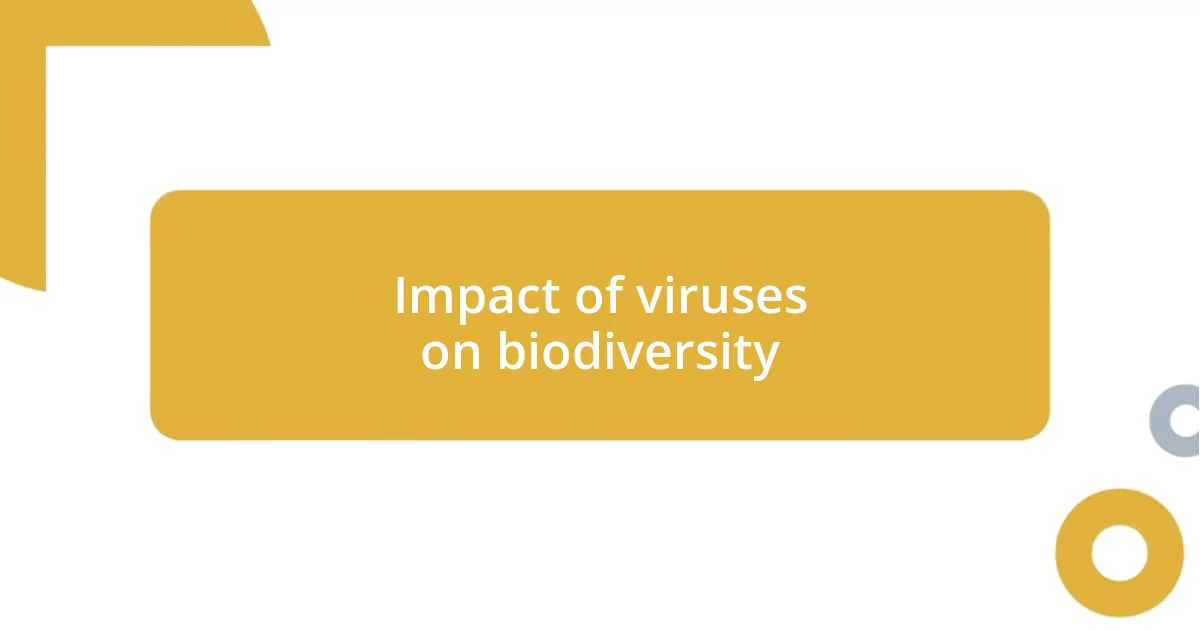
Impact of viruses on biodiversity
Observing the impact of viruses on biodiversity has truly opened my eyes to their crucial roles in ecosystems. I can still remember the day I visited a lush forest and stumbled upon a patch teeming with various fungi. In my excitement, I noticed how certain mycophages affected those fungal populations, carefully regulating their numbers. It’s remarkable to think that, without these viruses, one fungal species could dominate and potentially disrupt the delicate balance that supports a myriad of plants and animals. Isn’t it astounding how something so small can impact a whole community?
Then there was that experience at the beach, where I encountered a vibrant collection of marine life. As I observed the interactions among different species, I realized how specific animal viruses play an essential role in controlling populations of sea creatures. I watched small fish dart around, while larger ones feasted on their numbers. The thought struck me—what if those larger fish couldn’t thrive due to unchecked populations? Viruses help maintain this balance, promoting a diverse marine ecosystem. It’s like nature’s version of keeping the competition fair, don’t you think?
Reflecting on these experiences, I often wonder about the hidden complexities in our environment. I’ve seen firsthand how plant viruses can influence diversity through their role in keeping certain plant species in check. For example, while hiking in a mountainous area, I found vibrant patches of wildflowers that thrived alongside infected plants. Instead of competing, they seemed to coexist gracefully, suggesting that these viruses enable conditions for diversity to bloom. Wouldn’t it be fascinating to dive deeper into these interactions? Each of my observations reinforces a powerful message: viruses are more than mere threats; they are vital contributors to the tapestry of life, ensuring that diversity continues to flourish.
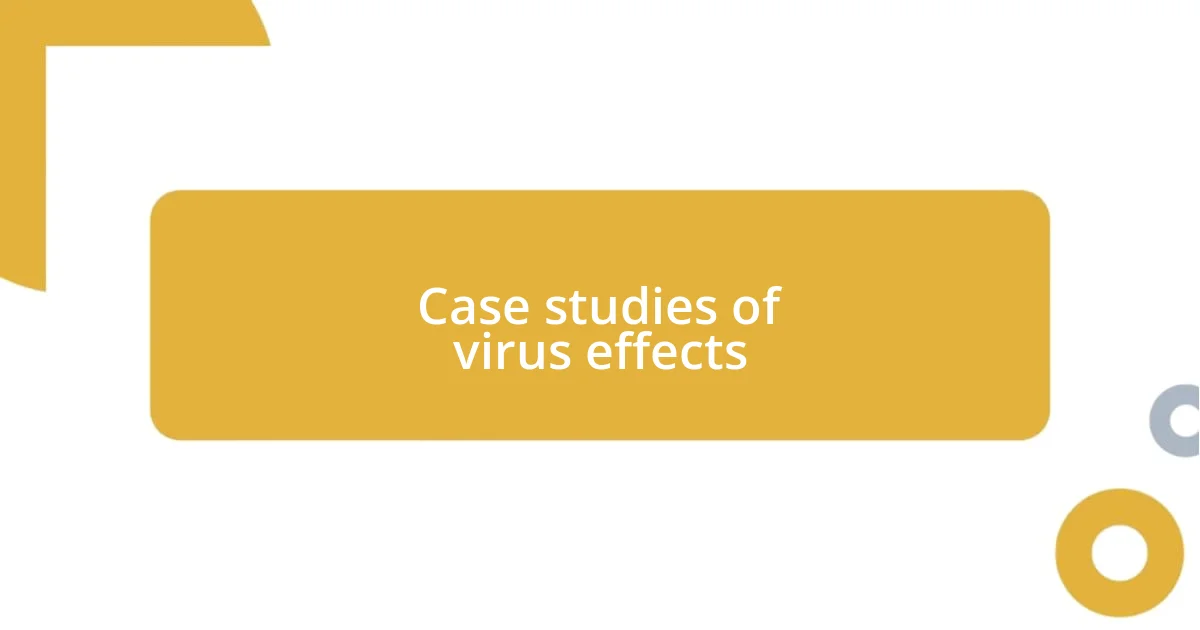
Case studies of virus effects
One of the most surprising aspects of my research was the profound impact of viruses on coral reefs. While snorkeling in a vibrant reef system, I witnessed how viruses infecting certain algal populations helped maintain a healthy balance within the ecosystem. It was astonishing to see that these viral interactions could prevent the overgrowth of harmful algae, allowing coral to thrive. As I watched the interplay unfold, I couldn’t help but question how many other ecosystems hinge on similar viral dynamics for their health.
In another memorable instance, while trekking through a damp forest, I stumbled upon a decaying log that was a hotspot for bacterial activity. Observing the bacteriophages at work, I felt a sense of wonder as they proliferated, ensuring that bacterial populations remained in check. This delicate balance reminded me of an orchestra, where each virus harmonizes with its bacterial host to create a thriving community. Isn’t it remarkable how a balance so delicate can have such significant implications for nutrient release? It’s a dance of life that often goes unnoticed but is crucial for sustaining the forest.
Then, there was that day I spent time on a riverbank, watching the effects of waterborne viruses on fish populations. I noticed how these viruses impacted healthier fish by targeting the weaker ones, creating a natural selection process. This realization struck a chord within me. It made me reflect on how even in the smallest microorganisms, there is a form of resilience and strength that promotes overall biodiversity. Wouldn’t it be fascinating to delve deeper into how these viruses shape not just populations, but entire ecosystems, steering them toward stability? Each observation often left me both humbled and curious about the unseen forces at play in nature’s intricate web.
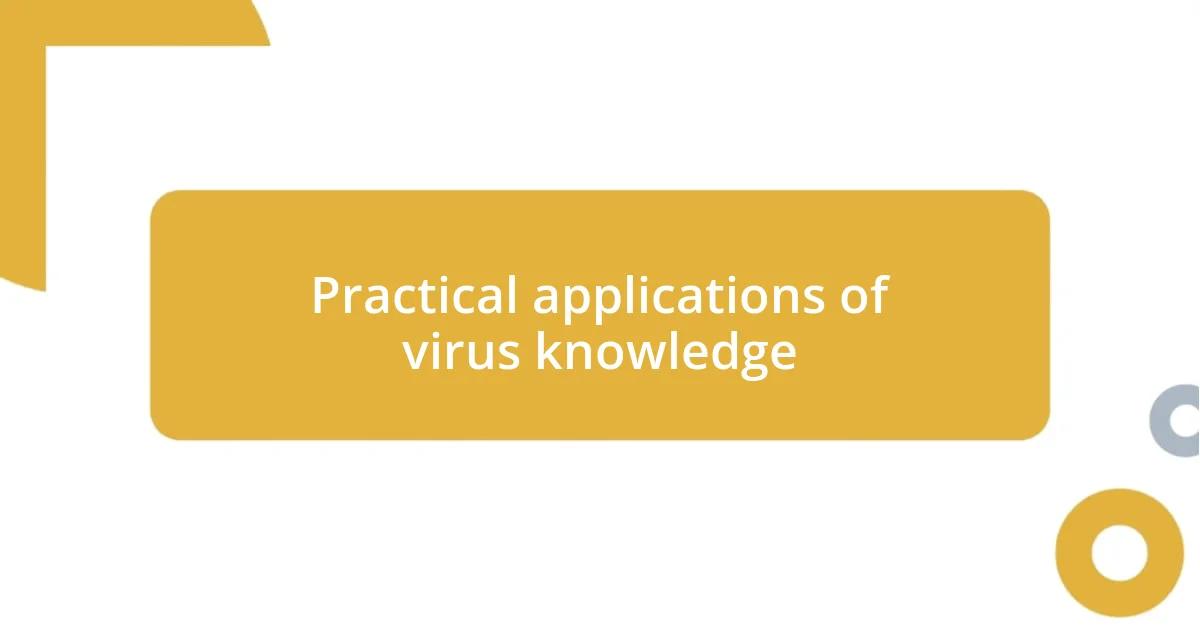
Practical applications of virus knowledge
When reflecting on practical applications of virus knowledge, I think of the potential for managing agricultural practices. I had the chance to visit a community farm where they discovered that certain plant viruses could help regulate crop yields. The farmers noticed that by allowing specific viral strains to circulate, they could defend against more harmful pathogens, ultimately leading to healthier plants. Isn’t it incredible that something as small as a virus can actually promote sustainable farming?
In my exploration of environmental science, I’ve also seen how researchers are harnessing the concept of bacteriophages in treating infections. I once attended a workshop where scientists discussed using these viruses as alternatives to antibiotics. As I listened to their passion and determination, it struck me how invaluable these solutions could be in combating antibiotic resistance. Who would have thought that viruses, often seen as the harbingers of illness, could emerge as heroes in our fight against bacterial infections?
Another fascinating area I’ve encountered is the use of viruses in biocontrol methods for pest management. During a visit to an organic vineyard, I learned how vintners were applying specific viruses to target pests that threaten their grape crops. I was amazed by this hands-on application; it showcased how viruses can serve as eco-friendly pest control agents. So, how do we further embrace this knowledge to create a more balanced ecosystem? This question lingers in my mind as I reflect on the myriad possibilities viruses offer in promoting harmony within our agricultural landscapes.












